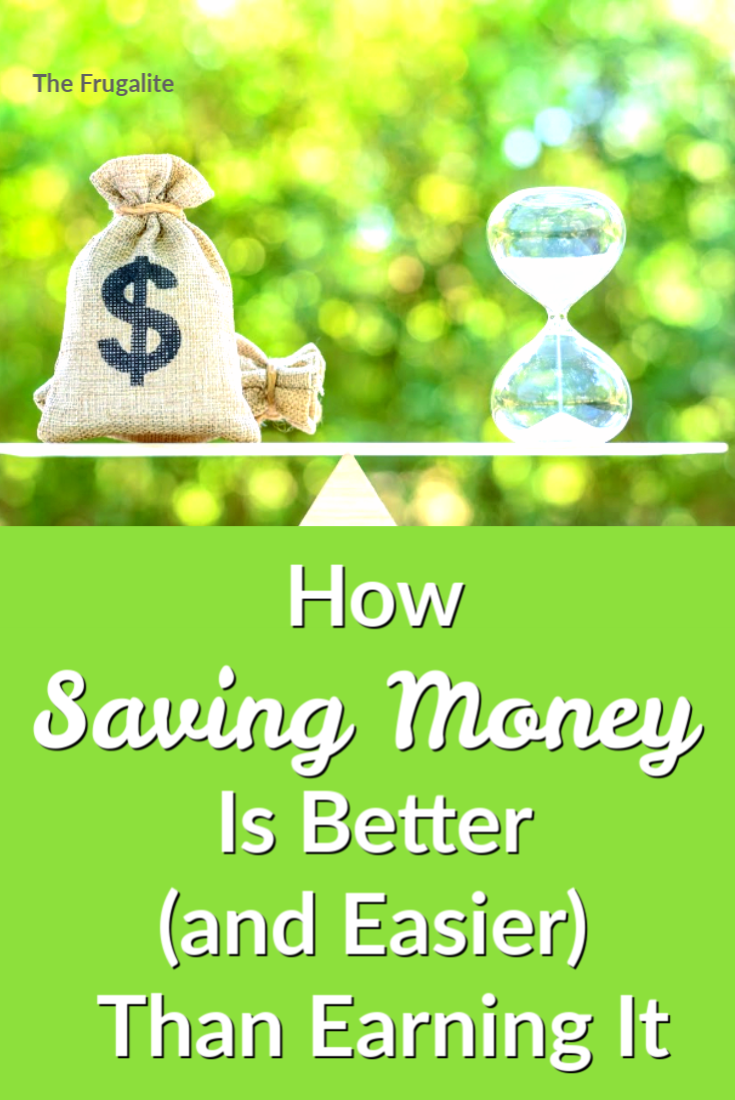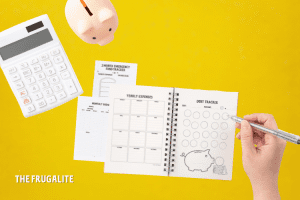(Psst: The FTC wants me to remind you that this website contains affiliate links. That means if you make a purchase from a link you click on, I might receive a small commission. This does not increase the price you’ll pay for that item nor does it decrease the awesomeness of the item. ~ Daisy)
There are a million websites out there dedicated to helping you make more money and that is often an essential part of setting your budget right. But even more important, in my opinion, is saving money.
Here are a few reasons why:
- You can’t be taxed on money you don’t earn or spend
- You get to spend more time with the people you love
- It’s usually easier to cut your budget than add to your income
- By reducing spending, you’re automatically better prepared for a financial rainy day
- Living thrifty is often much healthier
- You can teach your kids about money and handling a budget
There are many more benefits to saving money. Let’s take a closer look at a few of the most important.
Spend time or spend money
We live in a society in which we pay for convenience.
The very best way to save money is to spend time. This is one of the most valuable lessons I ever learned from my all-time favorite book, The Complete Tightwad Gazette.
Take a pizza, for example. Someone, somewhere, has to do the work to create that pizza. It might be more than one person. But you pay for every set of hands involved in getting that meal in front of you. In a restaurant, you might be paying for the cook and for the server. If you tend to get convenience meals at the grocery store, you are paying for someone else to have made the dough and assembled the pizza that you will in turn place in the oven at home.
But if you make that pizza yourself, you have taken the time to mix the ingredients, knead the dough, let it rise, punch it down, let it rise more, and finally roll it out onto your pizza stone or pan. Then you are spending your time making the sauce, spreading it on, and topping the pizza with your favorite meats, veggies, and cheeses. All in all, you’ll probably spend about an hour of hands-on time making that pizza. And time is money.
So, let’s take this down to dollars and cents. You might spend $30 to have that pizza at a restaurant or $15 to buy the pre-assembled pizza at the store. The ingredients are going to cost anywhere from $3-$5. This means that your hourly wage for making that pizza at home is approximately, at minimum $10 an hour, and at maximum, $25 an hour. Best of all, it’s tax-free and you know exactly what is in the pizza you make at home.
Here’s how much money you can save when one adult is at home.
Now, let’s look at a bigger example. Let’s take the average 10-hour workday (including commute, lunch breaks, etc.) Now spend that day productively at home. Here are some things you might do that other people pay for:
- Growing food $20
- Yard work $40
- Cleaning house $50
- Preparing food from scratch $30
- Mending clothes and doing laundry $20
- Childcare – all day, simultaneous with other tasks $75 for 2 kids
- Bathing and grooming the dog $65
- Walk the dog at lunchtime $10
- Make your own cleaning products and health and beauty aids $20
If you add all of those things up, you are talking about a LOT of money. I based my totals on the prices of those services and goods in my area, and on an average day, I could “earn” $330. Tax-free. On an annual basis of a 5 day work week, that is the equivalent of just over $85,000 per year. Again, let me reiterate: tax-free, which can save you another 15-30%.
Okay…I know that is not absolutely practical math and that people who work outside the home also do many of these things along with their workplace responsibilities. The point is, we all pay for conveniences unless we make a concentrated effort not to do so. We have all purchased laundry detergent at the store for 20 times what it costs to make a batch at home. We have all grabbed a frozen pizza to make our lives easier on a busy day. When we work outside the home, most of us have to pay someone to care for our children if we aren’t lucky enough to have family around to help out. All of this stuff adds up, and some of it can’t be helped.
It’s vital, though, to look at the savings you are able to make, as money. Spending your time instead of spending your money can be incredibly profitable.
Calculate value by how much time you spend working to earn what you’re buying.
So along these lines, have you stopped to consider whether or not all of the things that you do for money are really worthwhile? Or are you just trading that time for someone else’s time? We all have to keep a roof over our heads and keep the utilities on, but we don’t have to have all of the little luxuries that the marketing industry strives to convince us are necessities.
If you make $20 an hour, think about how long you have to work to earn the following:
- Starbucks coffee: 15 minutes
- Dinner for 4 at a restaurant: 3 hours
- Pre-made individual salads at the grocery store: 15 minutes
- Bathed dog: 3 and a half hours
Wow – when you look at it that way, it’s pretty eye-opening.
A thrifty lifestyle is great for your family
By doing things for yourself, you can save a fortune every year. You can reduce your outgoing expenses to the point that you might have the freedom to have one parent stay at home with the kiddos.
In turn, this can reduce your costs even more: suddenly there is no babysitter to pay and the at-home parent will have the time to do some of the other tasks for which you’ve previously had to pay for another person’s time.
Not only does this reduce your expenses though – it can improve your quality of life dramatically. Suddenly you have time for garden-fresh produce, home-canned spaghetti sauce, and playing with the kids. You can teach your children how to grow and dry herbs, take them for walks to the library, and live the lesson that time is far more valuable than money. You can include them on the journey towards a thrifty life and the reward is independent children who actually know their parents and know how to handle money when they get out on their own.
A thrifty lifestyle can be much healthier
Many of the things that you do to save money are far healthier than the conveniences that you pay for. This is only true, of course, if you consciously choose the healthier option and not just the cheap option. A few positive health benefits might be:
- Growing an organic garden
- Foraging for wild nuts and berries
- Getting lots of exercise through your homesteading activities
- Making non-toxic cleaning supplies from everyday items like vinegar and orange peels
- Cooking from scratch and avoiding nasty additives and chemicals
- Walking a few blocks to the post office and library instead of driving
- Using non-toxic reusable containers instead of purchasing disposable items wrapped in BPA-containing plastic (an expense initially that saves you a lot in the long run)
- Preserving your own food instead of buying packaged food
- Doing your own yard work (exercise, fresh air)
Making these choices means that you suddenly have a lifestyle free of the toxic chemicals that most people are surrounded by.
It teaches a self-sufficient mindset
Remember the old saying from the Depression?
Use it up, wear it out, make it do, or do without
That was always a creed in our house.
We use the dish soap right down to the very last drop, then we add water, shake it up, and use that for a couple of days. Before we began making our own toothpaste, we’d actually cut open the tube that most folks would throw out and have an extra week of toothpaste we could scrape out. A basket sits in the living room beside a comfy chair. That basket contains all of the things that need to be mended, as well as the necessary repair supplies. (I can’t be the only person who actually darns socks, can I?) When I sit down with my family to watch a movie on Netflix, I like to do the mending. If there is nothing that requires repair, I like to make things, like dishcloths, rag rugs, or gifts.
A lot can be done with an iron and some spray starch to make older clothes look crisp and new.
Most of the consumer goods today are designed with “planned obsolescence” in mind. I used to work in the automotive industry and learned that some vehicles are designed with a 3-4 year lifespan in mind. At that point, components begin to fail and many consumers will then replace the vehicle with a newer model. The same is true with many other goods that you buy in the store. The mass manufacturers intend that you purchase a replacement in a few years. Items are not engineered with the potential for repair.
When making purchases, I would prefer to spend more money on a solidly made item with fewer plastic parts because I know it will last longer and that I will be able to either repair it myself or have it repaired if it breaks down.
Defy the mass manufacturers by doing everything possible to repair an item before replacing it. And if it turns out that you MUST replace it, go for something of better quality if it is at all possible. Sometimes that better quality item might actually be an older item found at a thrift store or yard sale, because back in the day, planned obsolescence was not the goal of engineering like it is now.
Even better, don’t replace it at all. If you can find a way to “do without” the item, you’ve won. For example, my home has a dryer, but I rarely use it. I got out of the habit in a previous home because my dryer broke and I didn’t have the money to have it repaired or to replace it. I discovered that for a few dollars I could hang a clothesline and have fresh, crisp, air-dried laundry. What’s more, it didn’t run up my utility bills. Necessity bred a solution that was superior to the original situation.
I’m not much of a builder, but I’ve created relatively attractive bookcases using lumber that was kicking around the house and some sturdy boxes that I painted a nice color. When you think creatively, you’d be astonished at what you can create using what you already have on hand or can easily acquire from your environment.
When you think you “need” something, take a day or two to consider how you might be able to repair, substitute or adapt – often you will find that you didn’t actually “need” that item in the first place.
How do you save money by spending time?
The road to Frugalite Village is not earning more money – it’s spending less.
Do you have anything that you choose to do for yourself that other folks pay for? Do friends and family stand in awe of your thriftiness as they watch you refuse to pay for things that other folks spend money on every day? Share your ideas and stories in the comments below!












8 thoughts on “How Saving Money Is Better (and Easier) Than Earning It”
I cut my own and my husband’s hair. My daughters actually learned to cut their own hair, too.
And I had to laugh … yes, I darn my own socks, too :). And I hand-knit dish cloths.
I buy raw milk from a local farmer for $4/gallon and I make my own cheese. I invested in a soda stream. We make or buy bulk syrup and mix it ourselves.
I have to say that I LOVE this article! I have been a SAHM for 20+ years. Being frugal allowed us to have a pretty good life.
I love it !! For me I’m on a fixed income being a carers allowance for my two children with autism. At this stage of their development I can’t go to work. So I can’t increase my income but what I can do is being thrifty where I spend my money , I bake all our bread and treats , cook from scratch, have a garden for veggies, berries and fruit trees in pots , op shop our clothes or make them . Shoes and hiking gear are the exceptions but I buy them out of season and save up to 50% off , make all our green cleaners, collect rain water for gardening, save for everything don’t use credit, preserve and cook in batch. We have a once a week movie night, games night , weekly hiking , gardening , craft the recycling bin, and save save save , we actually live better than when I was working full-time earning triple the money I get for the carers allowance. And I’m so much more healthy than I was before. Also found a second hand copy of the tightwad gazette and just started reading it. Thank you for taking the time to create this site, I’m sure to hang out here to glean lots of tips !!
I’ve always said that it’s not about how much money you make, but how you manage it.
Years ago, when I was still working, I would only allow myself to live off what I made. Whenever I’d get a raise, I’d have that extra amount added to my 401-k. It was sure nice to see that account grow, and now that I’m retired and living off that money, I’m sure glad I got used to living on less.
I always try to make do with what I have. I may see something I think I need in my home, but instead of going to buy it, or ordering it, I will look around at other things I already have that might fill that need. At this point in my life, I’m working to not accumulate more, and to keep giving away what I don’t need.
Great article!
I started my own home daycare years ago because the math said that we would lose money if I worked outside the home. It worked well for over a dozen years and then the regulations got so cumbersome that it wasn’t feasible anymore.
I’ve had a home daycare before too, when my children were small. It’s a great way to stay home while still bringing in an income.
As inflation grows more and more we have to “do the math” in order to stay ahead.
What used to be a middle class income now puts people in the lower class.
There comes a point of diminishing returns where working two and three jobs starts to cost.
Having “trickle income” can sometimes be just enough to keep one afloat, without it costing.
Small trickles and drops of water will fill a bucket.
Well so will trickles and drops of cash.
Trickle income are things like turning in recyclables, scrapping metal, selling crafts, reselling items, etc.
2020 will be the year that sayings from the Great Depression will ring true.
Following them in the years to come will help you flourish.
I cut sponges that I wash dishes with in half, I use generic dish det and refill a pretty bottle. I do not drink soda. I eat oatmeal for breakfast everyday and I measure it out to last longer. I also drink a protein shake every day…. so I
Know what 2 meals are everyday. I am down to 1 load of laundry per week, using the minimum for detergent. I make my own coffee and only drink two medium cups per day.. I do buy new but I am a minimalist only select clothes get into my closet. I live in an RV so this makes sense for me. I have camped months at a time no site fees. My truck is 19 years old and going strong. I make my emergency (freedom) fund a priority!!
One thing I took away from the Tight wad Gazette was to figure out my true wage. To know what I really made per hour I added all the time that I spent getting ready and driving to and from work to calculate my actual work hours. Then I used my take home pay (not my gross salary) divided by my actual hours and found out I was only making a bit more than my babysitter.
At that point my husband and I made some changes. Later, when the kids were grown, I worked full-time again but drove to work with hubby and packed lunches, worked hard to keep our clothes nice (I’m a nurse, he is a teacher), and generally kept expenses down. We paid off bills and paid down debt before retirement.